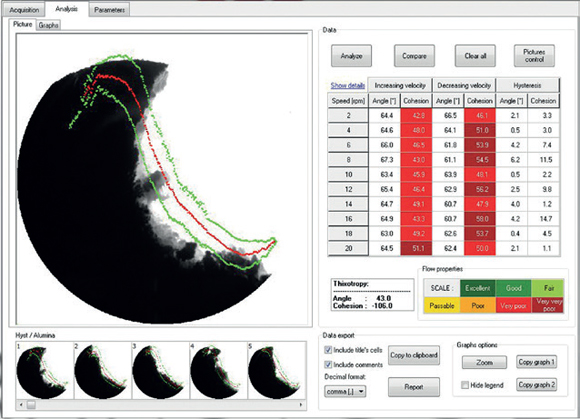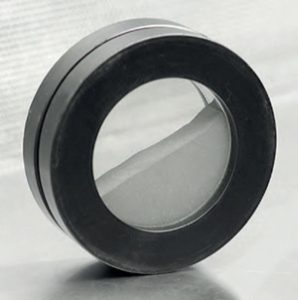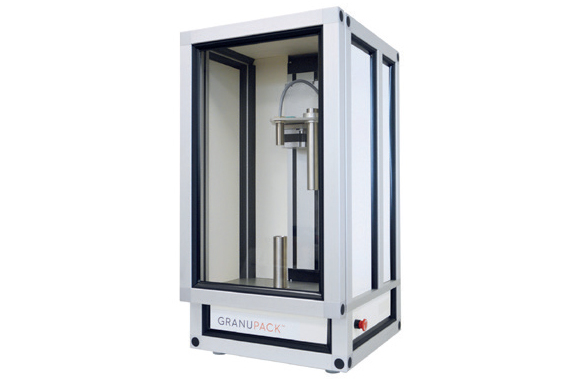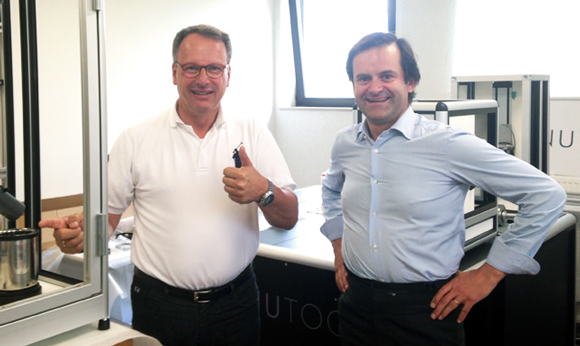Granutools offers metal AM process optimisation through powder characterisation
December 7, 2017
Granutools, Awans, Belgium, aims to help optimise the Additive Manufacturing process with its set of physical characterisation tools for metal powders. The tools help users understand the macroscopic behaviour of metal powders for Additive Manufacturing, and can reportedly be applied to any application which uses metal powders.
Granutools was founded in 2015 to address the industry’s need for simple, precise and repeatable measurement techniques for powders. According to the company, powder properties are key to accelerating the adoption of AM in volume manufacturing. In order to obtain a thin layer in Additive Manufacturing, the powder must be as fine as possible.
Unfortunately, when grain size decreases, the cohesiveness increases and the flowability decreases. Moreover, the powder becomes more and more sensitive to moisture. Therefore, a compromise between grain size and flowability has to be found. The quality of the part’s build with AM has directly related to the powder flowing properties; the flowability must be good enough to obtain homogenous successive powder layers.
For all processing methods dealing with powder, the measurement method used to characterise the powder should be as close as possible to the process. In particular, the stress state and flow field of the powder should be comparable in the measurement cell and in the process.
To optimise the AM workflow, Granutools recommends the use of Granudrum, which assesses powder spreadability to select precursors and optimise recoater speed, Granupack, as a quality control which is related to part porosity and surface roughness, and Granucharge for powder reusability.
Powder flow properties
The company’s Granudrum is a dynamic angle of repose analyser. The automated instrument provides quick and precise measurements of granular materials’ flowing properties. It works on the rotating drum measurement principle associated with a customised image treatment algorithm, and provides cohesive index and flowing angles for different shearing rates.

Granudrum’s software provides cohesive index and flowing angles for different shearing rates
In traditional flowmeters such as shear cell testers and rheometers, Granutools states that the existence of a compressive load on the powder being measured contradicts the free surface flow of powder in an AM device, meaning measurements taken using traditional methods are not relevant for AM.

Granudrum works on the rotating drum measurement principle, associated with a customised image treatment algorithm
The rotating drum measurement method used in the Granudrum enables the analysis of powder flow precisely at the powder/air interface, without any compressive load. In addition, the rotating drum’s geometry allows users to study the natural aeration of powder during flow. By measuring the cohesive index of a powder, users can avoid the formation of waves on the powder bed and predict optimal recoater speed to obtain a homogenous layer.
Powder density
Granupack provides rapid, precise measurements on the density curve of a granular material versus the tap number. The parameters obtained from these measurements can provide information about both powder density and powder flowability.

Granupack, one of Granutools’ offerings, is a high-resolution tapped density analyser for precursor quality control
Contrary to classical manual tapped density measurement, Granupack is said to measure powder compaction curve – powder density plotted as a function of the tap number – very precisely, thanks to measurement automation (ruling out user error) and an initialisation protocol.
From this compaction curve it is possible to analyse the optimal density, the compaction range and the compaction speed of the powder, enabling users greater control over the porosity and surface roughness of the final AM part. Due to its high accuracy and repeatability, Granutools states that this instrument is the best candidate for precursor quality control.
Electrostatic charge measurements
Granucharge is an automated instrument able to measure the build-up of electrostatic charge inside a powder while flowing on surfaces of various natures. The electric charge density of a powder is measured using a customised Faraday cup, after a controlled flow inside a vibrating V-shaped conduit. The charge time evolution is then plotted and analysed within a dedicated software.
The presence of electric charges in a powder induces cohesive forces, leading to the formation of undesirable agglomerates. Measuring the electrostatic charges created by a powder enables users to predict flowability deterioration during processing, for example during layer formation in AM, to analyse the surface state of grains for oxidation, contaminants and roughness, and to quantify the ageing of a reused powder precisely.

Stefan Ritt, SVP Global Marketing of SLM Solutions (left) met with Filip Francqui, Managing Director of Granutools, during a recent visit to the factory in Awans, Belgium
Process optimisation for industrial and research applications
Granutools now supports a number of industrial customers globally, in North America, in Asia and throughout Europe. The company was recently visited at its factory by Stefan Ritt, SVP Global Marketing of SLM Solutions. Speaking on Granutools’ technology, Ritt stated, “As manager of standardisation work groups in ASD-STAN and DIN I appreciate the work of Granutools to make equipment for standardised tests on metal powders. This help establish standardised processes in future manufacturing.”
McGill University, Canada, is involved in a research partnership with Granutools for the analysis of the dynamic behaviours of aluminium, titanium and superalloy powders. Professor Mathieu Brochu, head of the university’s P2AM2lab, stated, “Both Granutools and McGill are developing key knowledge in this field and pushing further the advances on powder optimisation for AM application. Our Granudrum is the first one in Canada, and is having traction with national and international key players in the AM field.”
ENGIE Laborelec has selected Granupack and Granudrum to complement the capabilities of the ENGIE Powder Lab, which aims at characterising metal powders and fostering prequalification activities of material feedstock for powder bed fusion processes. “Granudrum and Granupack provide a quick automated solution to deliver accurate data on powder rheology for a better understanding of flowability and spreadability behaviour that metal powders can encounter during shipment, storage or powder delivery and spreading during powder bed fusion processing,” stated Steve Nardone, Project Manager Metal Additive Manufacturing.
The SIRRIS research centre in Belgium also uses Granutools instruments. Oliver Rigo, Senior Engineer Additive Manufacturing, added, “We are now implementing the use of these instruments in our Additive Manufacturing lab for periodic quality testing in order to detect quality drifts throughout the AM process steps. We have chosen Granutools for both the precision and repeatability of their instruments, and the applicability of their technology for AM.”
















